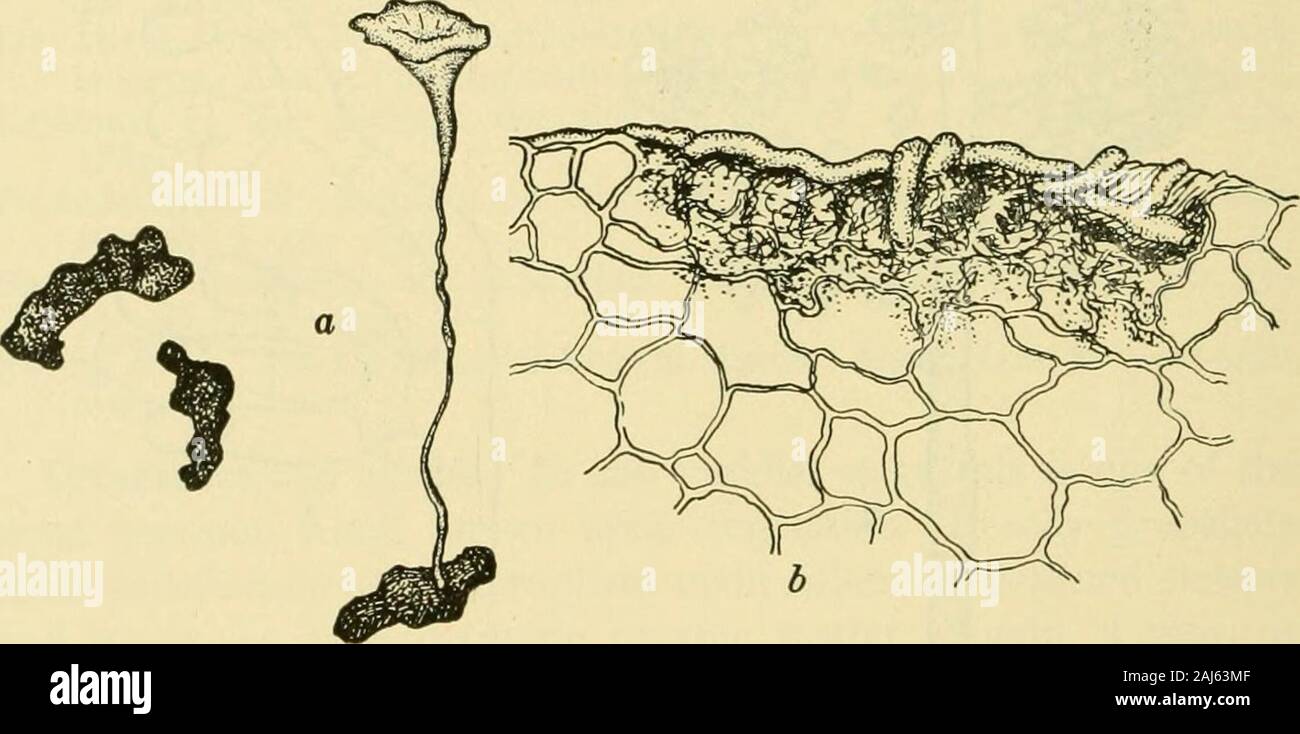Fungous diseases of plants . first connected this conidial stage with an apothecialform, Sclerotinia Fnckeliana, produced from sclerotia of the Bo-trytis on grape. Subsequently doubt arose regarding this connec-tion, since many observers failed repeatedly to secure under any 1 Ward, H. Marshall. Ann. Bot. 2 : 319-382. ph. 20-24. 1888. 198 FUNGOUS DISEASES OF PLANTS conditions the perfect form from sclerotia of the Botrytis. It wouldseem that Istvanffi has now secured substantial proof that theseare pleomorphic stages of a single fungus. Much interesting biological work has been done upon thisf

Image details
Contributor:
The Reading Room / Alamy Stock PhotoImage ID:
2AJ63MFFile size:
7.1 MB (235.1 KB Compressed download)Releases:
Model - no | Property - noDo I need a release?Dimensions:
2245 x 1113 px | 38 x 18.8 cm | 15 x 7.4 inches | 150dpiMore information:
This image is a public domain image, which means either that copyright has expired in the image or the copyright holder has waived their copyright. Alamy charges you a fee for access to the high resolution copy of the image.
This image could have imperfections as it’s either historical or reportage.
Fungous diseases of plants . first connected this conidial stage with an apothecialform, Sclerotinia Fnckeliana, produced from sclerotia of the Bo-trytis on grape. Subsequently doubt arose regarding this connec-tion, since many observers failed repeatedly to secure under any 1 Ward, H. Marshall. Ann. Bot. 2 : 319-382. ph. 20-24. 1888. 198 FUNGOUS DISEASES OF PLANTS conditions the perfect form from sclerotia of the Botrytis. It wouldseem that Istvanffi has now secured substantial proof that theseare pleomorphic stages of a single fungus. Much interesting biological work has been done upon thisfungus. Infection results most readily from sclerotia or froma mycelium which has been growing saprophytically. Infectionfrequently fails when conidia germinate directly upon the sur-faces of delicate parts. Upon penetrating a plant there is, first, a direct poisoning effect, supposedly due to oxalic acid, resultingin the death of adjacent cells ; and, second, there is more or lessdigestion of the cell contents and membranes.. Fig. 75. ScLEROTiNfA LiBERTiANA. (After R. E. Smith)(7, sclerotia and apothecium ; b, penetration of hyphae Control. In the case of this fungus, as well as the species ofSclerotinia next discussed, good sanitation is important. Never-theless, in the greenhouse it may be necessary to sterilize thesoil in order to control the disease effectively when it becomes virulent. IX. LETTUCE DROP Sclerotinia Libertiana Fuckel Humphrey, J. E. Diseases of the Cucumber Plant. A Sclerotium Disease.Mass. Agl. Exp. Sta. Rept. 10: 212-224. pl^- J-^- 1892. Smith, R. E. Botrytis and Sclerotinia: Their Relation to Certain Plant Dis-eases and to Each Other. Bot. Gaz. 29: 369-407. ph. 2^-2y. Stone, G. E., and Smith, R. E. Drop of Lettuce. Mass. (Hatch) Exp.Sta. Rept. 9: 79-81. 1897. (Compare, also, 10: 55-58, 1898; and 11:149-151, 1899.) ASCOMYCETES 199 Symptoms, effects, and hosts. It is difficult to determine howmany of the reported sclerotial diseases of greenhouse and gardenc